Did you know that game dev companies pay as much as$80,000 for a single virtual avatar? Character modeling is regarded as a crucial aspect of games’ success.
What Is the Most Important When Making 3D Character
3D character modeling is a way to build a visual connection with customers in your niche. The character can be either a living being or a made-up creature. Anyway, an engaging character makes players enjoy your game more.
How to Make 3D Characters – Step-By-Step Guide
The process of creating a 3D character is complex and comprises stages of preparing a concept art, modeling, texturing, rigging and skinning, and animating. They are detailed in the step-by-step guide below.
When making a 3D character, you should pay attention to the following steps:
Creating a Concept Art

How to make 3d character models, and where to start?
3D character modeling starts with crafting concept art — it’s a visual representation of the intended character design. They are simply sketches used to create the visual part further. Concept art may not be complemented by background elements but should convey a character’s contours, colors, and shapes.
3D Character Modeling

Screenshot source: https://www.animationmentor.com/blog/new-workshop-introduction-to-3d-character-modeling/
3D modeling is also known as character prototyping. It is basically the process of making a three-dimensional model of an object. This approach aims to develop a visual image of the desired object.
The 3D character modeling process is done in four steps:
Blocking. Creating a basic shape of a character, its skeleton, and muscle frame.
High poly modeling. Building a 3D model from a high number of polygons — geometric shapes. The high poly count is roughly 30,000 or more, depending on the complexity of a model.
Retopology. Logically organizing and aligning polygons is regarded as basic construction components of 3D models. It is necessary to ensure the correct automated animation of characters further.
Baking. Applying high poly elements to lower poly models to ensure consistency in a character’s appearance without compromising surface quality.
After a three-dimensional character is prepared, it can be textured, given a digital skeleton, and animated.
Character Texturing

Screenshot source: https://www.cgmasteracademy.com/courses/119-character-texturing-for-games-in-substance/
Production and application of a character’s texture to its 3D model ascertain its excellence, originality, and correctness. Texture is regarded as a bitmap applied to the surface of an unpainted model to give it the color, volume, or appearance of relief.
Texturing is classified into two types: relief mapping and MIP mapping. The first one is the use of a special graphics 3D tool that allows you to create an object’s surface with displacements per texel regarded as a unit of measurement of a texture map. It is needed to show varying heights or depths of volumetric figures in a realistic manner.
In turn, MIP mapping is a special texture mapping method that employs several copies of the same texture picture with varying degrees of resolution. It is mostly helpful when some elements present in a character’s appearance need to be downscaled.
Texturing is needed for the visualization of physical attributes and replication of the effects of light and reflection. It also contributes to the most realistic display of the tiniest elements such as eyelashes, scars, moles, birthmarks, and skin pores.
When the texturing is complete, the model is likewise complete. If the model is to be animated, all subsequent procedures take place.
Character Rigging and Skinning

In this stage, game characters are given a skeleton, with the assistance of which they are later given the ability to move. A rig, or a virtual skeleton, is a representation of the virtual bones and joints. They connect parts of the character’s body.
Skinning is attaching the character’s geometric mesh to the newly generated rig. It helps to change the look of the characters depending on the action they perform. After this step, the model is prepared for being animated.
Character Animation

Screenshot source: https://www.youtube.com/watch?v=TjJLIuFKA20
The animation is a short presentation of a sequence of static pictures, known as frames that differ in tiny aspects. The primary objective, at this point, is to produce the most realistic motion of 3D characters possible.
For this purpose, a designer should provide the location of the 3D character in the first and last frames of the movement. The frames in-between are calculated by specific software. As a result, the design receives a single, realistic motion.
This animation technique may seem straightforward, but animating becomes more challenging with the increase in complexity of 3D character movements.
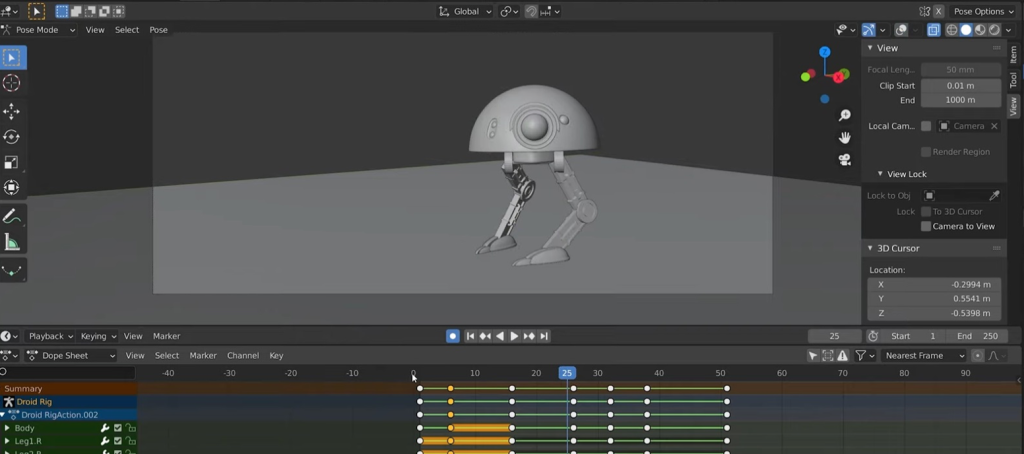
Screenshot source: https://www.youtube.com/watch?v=duGHtPOL7VA&t=1619s
Porting 3D Assets Into Game Engine
After a 3D model is fully prepared, it can be ported into any of the game engines. Those are frameworks designed for the development of games. They have their internal middleware libraries to which you can port your newly created 3D assets.
Examples of popular game engines are Unity, Gamemaker, Defold, Unreal Engine, and CryEngine. All of them have broad capabilities to integrate your 3D models into game environments.
Addressing Performance Optimization
Achieving exceptional 3D characters requires prioritizing performance optimization. Addressing this concern involves adeptly reducing polygon count, optimizing textures, and utilizing LODs (Level of Detail) for smooth in-game performance while preserving visual appeal. By strategically simplifying polygonal structures, developers can enhance rendering efficiency and resource allocation, leading to consistent frame rates. Optimizing textures through atlasing, compression, and streaming minimizes memory usage without compromising visual fidelity.
Implementing LODs allows seamless transitions between character models of varying detail, saving processing power when characters are distant or less relevant. This harmonious blend of techniques ensures that 3D characters captivate players with their visual charm, all while maintaining optimal performance on diverse gaming platforms. In essence, mastering performance optimization empowers developers to craft immersive gaming experiences that leave a lasting impression.
Top 3D Character Modeling Software

Artists that wonder how to make 3d video game characters may experience difficulty choosing suitable modeling software. There is a digital solution for everyone, from complete beginners to specialists looking for the most advanced modeling features.
Here are the top character modeling software solutions for creating 3D realistic imitations:
Maya
Maya is a program designed to create 3D graphics. It has been a leader among other specialized utility tools for more than 20 years. Many modern cartoons, games, and films have been created using this software.
Maya is the top software among Hollywood specialists. General users may not like that the program has high system requirements, which most everyday computers do not meet.
Poser
Poser is one of the leading 3D animation and rendering software solutions. Its developers definitely know how to create 3d characters and animate them effectively.
The program converts photos into lifelike images and videos. Such pieces are suitable for movies, games, and print. Poser is great for incorporating pre-configured, fully textured, and rendered 3D models into game development.
Zbrush
Zbrush is a great tool for creating and editing 3D graphics, intended mostly for experts. It exploits techniques of digital sculpting, texturing, and painting.
The program is designed to work with some sort of “digital clay,” from which you can physically construct items using various tools.
Blender
Another open-source 3D software, Blender is regarded as one of the greatest 3D modeling programs available due to its vast functionality.
Blender can be used at any stage of 3D character creation: modeling, rigging, animating, rendering, and video editing. Novices usually start to learn how to make a 3d character model using Blender.
“As the Head of Game Art Production at iLogos Game Studios, I firmly believe that a combination of Autodesk Maya and ZBrush would be our best choice for 3D character modeling. Maya’s comprehensive set of tools and integration capabilities streamline the entire character creation pipeline, while ZBrush’s unparalleled sculpting abilities enable us to craft intricate and realistic character details. By leveraging the strengths of these two powerful software solutions, we can ensure that our game characters exhibit the level of quality and artistry that sets our games apart in the industry.”
Where to Get Ready-Made 3D Models

The websites listed below offer you a range of free-to-use models:
- Free3D. Offers a large number of high-quality free models. The website was created by artists-freelancers and is regularly updated due to users’ donations of 3D assets.
- Sketchfab. A 3D models marketplace that allows you to examine the model from various angles in a three-dimensional environment. It even provides the opportunity to show digital prototypes’ wireframes.
- CGTrader. Includes a wide library of models with higher or lower polygon count. Some of them are fully rigged and are ready to use in animation making.
Industry Trends in 3D Character Modeling
In the rapidly evolving realm of 3D character modeling, industry trends have witnessed remarkable strides in recent times. Notably, the rise of stylized characters has taken center stage, as artists and designers experiment with diverse aesthetics that transcend realism, adding unique and imaginative elements to their creations. Simultaneously, procedural generation techniques have revolutionized the workflow, enabling the automatic generation of characters through algorithms and rule-based systems. This advancement has not only boosted productivity but also unlocked new possibilities in character variations and design exploration.
Moreover, the integration of AI-driven tools has been a game-changer, empowering artists with intelligent solutions for tasks like facial expression rigging, motion capture, and even character personality development. These cutting-edge tools streamline the creation process and open doors to more accessible and inclusive character design, enhancing the overall narrative potential of 3D artistry.
How Much Does It Cost to Create a 3D Game Character?

The price of creating a 3D game character depends on several main factors:
- The complexity of a character’s model;
- The number of hours spent on the creation;
- Level of the artist’s expertise;
- The region where the artist lives.
Let’s review the approximate regular 3D model development time. The concept creation is approximately 20 hours, while modeling may take up to 50 hours. Texturing and rigging are roughly 15 hours. And making one second of animation takes five hours of real-time on average.
In essence, three seconds of character modeling & animation takes about 100 hours. Assuming that the averagehourly pay of a designer is $30, the approximate price is $3,000. When it comes to actual work, it is better to consult agame art studio so you can have more detailed information about exact estimates.
Why is Collaboration important in Character Design?
Collaboration emerges as the cornerstone of success in Character Design. The seamless integration of character artists, animators, and game designers is paramount to forge characters that transcend mere aesthetics, resonating with the game’s narrative and mechanics. By fostering a cohesive synergy between these teams, the resulting characters not only visually impress but also become a pivotal element in driving the game’s immersive experience.This collaborative process entails ideation, iterative feedback loops, and cross-disciplinary knowledge sharing, enabling the realization of characters with depth and purpose.
Additionally, acknowledging the significance of partnering withgame art outsourcing studio, such as iLogos, further bolsters the project’s potential, as it harnesses specialized expertise and expands creative horizons. In sum, the essence of successful 3D character modeling lies in embracing the power of collaboration, uniting artistic vision with technical finesse to breathe life into unforgettable virtual personas.
Best Types of Collaboration With 3D Character Game Artists

Outsourcing character modeling is the most beneficial type of cooperation for both parties. This business practice means hiring an agency or an individual artist outside of your company. It enables you to choose the most suitable artist for you from a large talent pool and get the desired result within the agreed time frame and at a reasonable price.
Another type of collaboration you may consider is a direct employment. It implies offering a monthly payment to an artist in exchange for 40 working hours or a predefined amount of creative work done. It is beneficial when you have a huge workload.

Looking For Character Design? Ensure Its Success With ILogos Team!
Wrapping Up
In essence, game character modeling is an integral part of making an entertaining game of any type.
A tremendous amount of work is required to create a vibrant and unforgettable character. But it’s worth all the effort as the more creativity poured into the characters, the more likely they are to become famous in game development history.
FAQ
How Do You Make a 3D Game Character?
The 3D game character development process consists of the following five stages:
- Concept art creating.
- 3D character modeling.
- Character texturing.
- Character rigging and skinning.
- Character animation.
How Much Does It Cost to Create a 3D Game Character?
The approximate cost of one 3d game character is about $3,000-4,000. Prices for photorealistic models may fall somewhere between $5,000-6,000 — although it depends on the abstract model and the overall complexity.
What Is the Best 3D Character Modeling Software?
Zbrush, Blender, Poser, and Maya are usually great choices for most artists.
What Is 3D Character Modeling?
3D character modeling is the creation of virtual models in three-dimensional space using specialized software.
- #character modeling
- #game art
- #game development
UNIVERSAL
CHARACTER SYSTEM
Character Creator (CC) is a full character creation solution for designers to easily generate, import and customize stylized or realistic character assets for use with iClone, Maya, Blender, Unreal Engine, Unity, or any other 3D tools. CC connects industry-leading pipelines with one system for 3D character generation, animation rigging, asset management, look-dev rendering, and interactive design.
WHAT’S NEW
A truly accessible, controllable, and editable wrinkle-blending system driven by facial expression morphs.
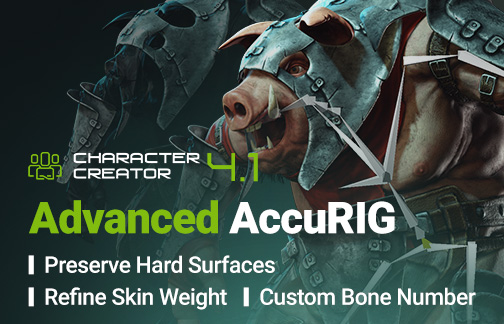
Auto rigging humanoid 3D models.
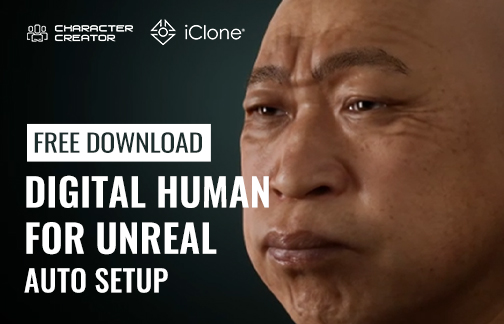
Automatic Shader and Skeleton Assignment for Characters & Assets
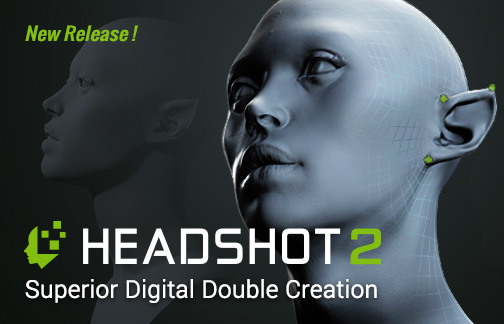
Turn static mesh into fully-rigged CC character.
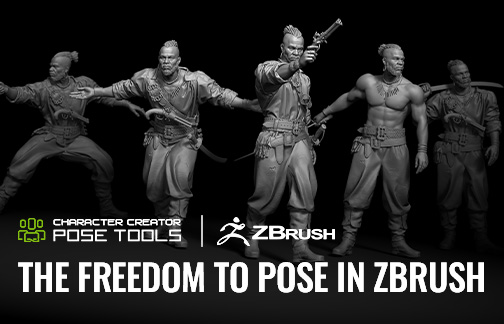
Transform intricate sculpts into posable masterpieces in just a few clicks.
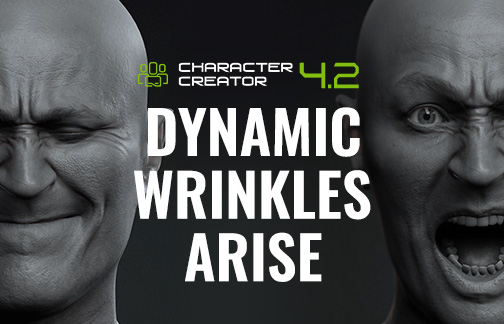
A truly accessible, controllable, and editable wrinkle-blending system driven by facial expression morphs.

Auto rigging humanoid 3D models.

Automatic Shader and Skeleton Assignment for Characters & Assets

Turn static mesh into fully-rigged CC character.

Transform intricate sculpts into posable masterpieces in just a few clicks.

A truly accessible, controllable, and editable wrinkle-blending system driven by facial expression morphs.See More >
3D CHARACTER CREATION CHARACTERIZE ANY ACTOR TO CC
Whether humans, creatures or props, creativity is no longer limited by the existing CC character base. Any rigged biped models can be imported, characterized, and facial rigged in Character Creator. New features now make any character compatible with thousands of motion assets, ready for natural lip-sync, motion capture, and animation controls in iClone. CC characters can also be optimized for low-poly, high-performance crowd simulation, AR, VR, and Metaverse.
3D CHARACTER CREATION CHARACTER SCALABILITY
Character Creator gives character designers the largest possible character usability with the CC character base for character design, importing humanoid characters, or auto-rigging static models. Choose to subdivide and export characters for highly-detailed rendering, or decimate characters for mobile apps or crowd simulation.



3D CHARACTER CREATION TOTAL CHARACTER DESIGN
All-in-one tools to design engaging characters, easily adjust character shapes, define skin looks, change hairstyles, dress for animation tests, import and rig new character assets, or even create characters from photos.
3D CHARACTER CREATION SMART ASSET MANAGEMENT
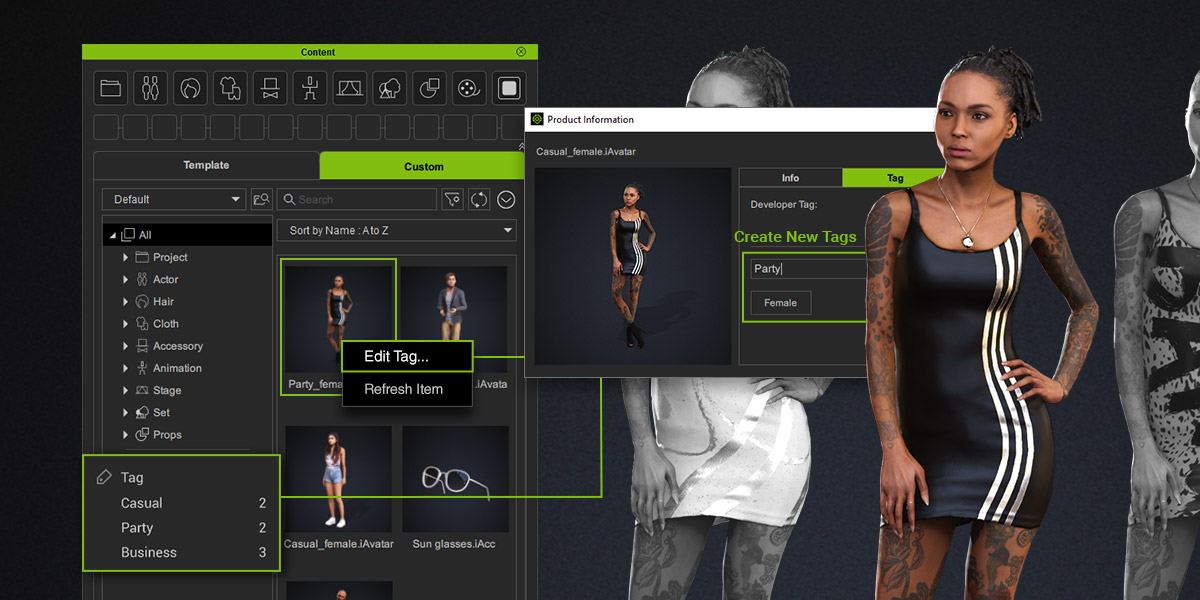
3D CHARACTER CREATION FREE RESOURCES
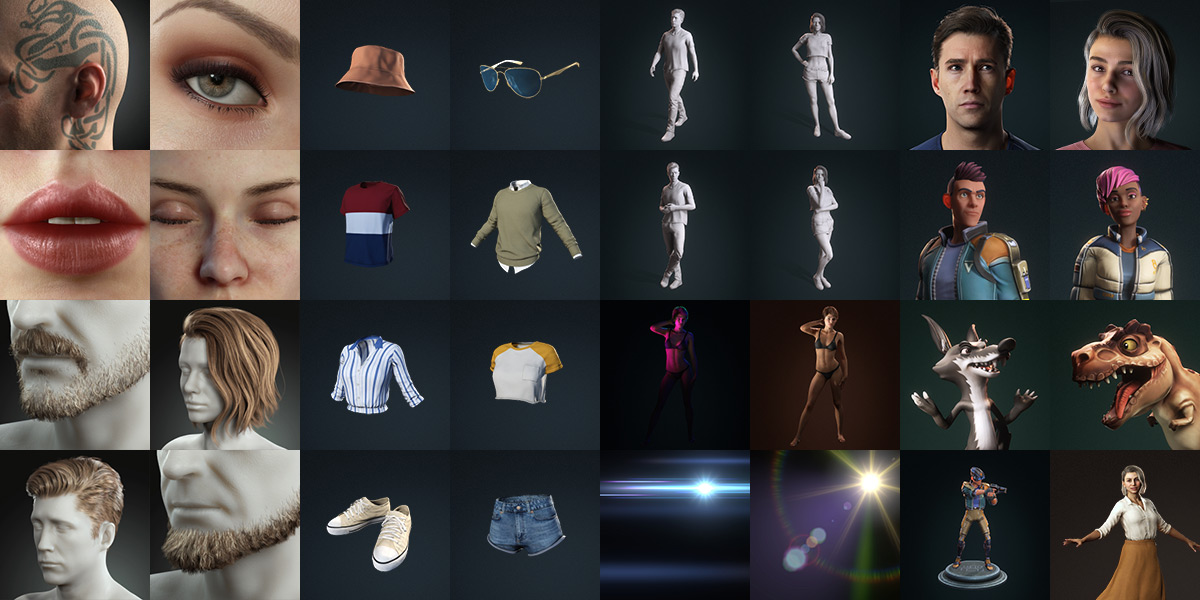
3D CHARACTER CREATION SMART ASSET MANAGEMENT

3D CHARACTER CREATION SUPPORTING MAJOR CHARACTER WORKFLOW
Character Creator provides free addons to speed up the character design workflow with major industry tools, such as GoZ for ZBrush, CC Tools for Blender, CC AutoSetup (shader and bone structure) for Unreal Engine and Unity Mecanim, UDIM compatible with Substance Painter, and rigged character compatibility with Marvelous Designer.

3D CHARACTER CREATION ECOSYSTEM
Access the largest premium character library made by top designers and enjoy the consistent drag-and-drop experience to build new designs using thousands of characters, morphs, skin, outfit, shoes, hair, accessories, and motions are at your selection.
Participate in the marketplace designer community and profit from your creativity.
We are an experienced professional Team of game developers having over 10 years of experience in game development and open world game with multi-user character interaction.
Our Staff can develop any kind of game including 3D, 2D, hyper-casual, action, puzzle, adventure, VR, AR and many more for all type of platforms.
We are an out sourcing studio in the game industry, open world games and interactive chat with 3D avatars.
We focus on delivering high-quality games with great performance, indeed, performance and quality are the most important aspects of great games, alongside code quality and on-time delivery.
We made many games of different genres on unity, unreal engine, roblox engine and three.js
Send us your ideas, let’s discuss them and develop your customized project.
Our services include:
- Cross platform games
- Game concept and level designing
- Multiplayer integration
- Re-skin
- Ads and in-app purchase
- Game Optimisations
- 2D/3D Animation
- Graphic Designing
- Social Network Integration
- Virtual Reality (VR)
- Augmented Reality (AR)
- Game icon
- Promotional graphics and videos
- Appstore and Playstore publishing
- Firebase Integration
CONTACT US
Error: Contact form not found.